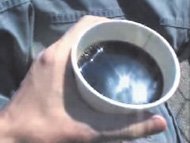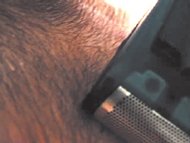Editing Styles
| Understanding the editing process is one thing; developing a personal editing style is another. Editing style refers to the approach you take to string your shots together. There are a few different editing styles vloggers can choose to get started. By familiarizing yourself with different styles, you have some ready-made approaches to draw from when you sit down for your first edit. As you continue to create videos for your vlog, you might decide to mix things up a bit, depending on your subject matter, your intentions, and your mood. The Single TakeA single take is simply a video that consists of one continuous shot. The camera may be stationery or it may move, but it's still just one shot. This style is used frequently and quite effectively by vloggers (Figure 5.18). The major challenge in editing a single take is choosing exactly where to start and end the video. If you're editing a video that you planned ahead of time, you've probably rehearsed and worked on the beginning and ending in the shooting process. If, on the other hand, you're editing a video of something you just happened to catch on camera, you'll probably have a number of choices about where to make your edits. If you're not sure where to start or end, ask yourself this question: What is the shortest section necessary to tell the story? While you should aim for brevity when editing footage for your vlog, don't go overboardit still should be as long as it needs to be to tell your story. Figure 5.18. Jay Dedman's "Looking at Things" from the Momentshowing vlog (www.momentshowing.net/momentshowing/2004/07/videoblog_16_lo.html) is artfully captured in a single takeincluding the unexpected ending. Pay attention to the pace toward the end, which gives viewers time to absorb the change in setting.
Using B-roll and CutawaysLet's say you're editing an interview or a shot of someone talking directly to the camera about gourmet coffee. You can use the shot in its entirety if it's the right length and says what you want it to say. But let's say you want to cut out the off-camera questions. Do that and you'll end up with a jump cut, which gives you a splice between two very similar but not identical frames. It's called that because the results can be, well, jumpy. After the cut, the person on camera may appear to "jump" into a different position. One way to visually smooth over a jump cut is to insert a piece of video between the two interview cuts that shows something else that's relevant to the story, perhaps a close-up of a steaming hot cappuccino. This extra footage is referred to as B-roll. B-roll provides extra visual information that you can use to illustrate what someone is talking about or to provide an additional detail about someone or something. When you're shooting, remember to shoot some B-roll footage so you'll have extra material you can use to cut away from the person speaking to show a different piece of video, while the person's audio continues underneath. These edits are referred to as cutaways (Figure 5.19). Figure 5.19. In Chris Weagel's "The Haberek, Pt.2" from the Human Dog Laboratory vlog (www.human-dog.com/lab/?p=180), B-roll footage was used for cutaways that give us insight into the man being interviewed.
Quick CutsQuick cuts let you visually compress the time span of a long sequence by including just enough brief glimpses of the action for an audience to follow the story. Let's say you've filmed a woman walking out of her apartment, waiting for the elevator, riding the elevator down five floors, people entering the elevator along the way, and finally the woman exiting the elevator and the building and walking out to the street. In real time the whole experience took maybe three minutes. If the footage was intended only as a set up for the story that actually took place on the street, those three minutes is probably much too long. Using quick cuts to compress that sequence, you could simply show the apartment door being pulled closed, the elevator door opening in the lobby, and your subject stepping out onto the street. Viewers would still have the factsthat this woman left her apartment and went outside, but they would get them in ten seconds instead of three minutes. This video entitled "Cut" takes the idea of quick cuts to the extreme and transforms what could be a pretty uneventful video of a haircut into a work of art (Figure 5.20). Figure 5.20. Tom Laczny's "Cut," from the Fast Moving Animals vlog (http://fastmovinganimals.blogspot.com/2006/01/cut.html), condenses a 15-minute haircut into a fast-paced barrage of clips that clock in at less than 60 seconds.
|
EAN: 2147483647
Pages: 81


